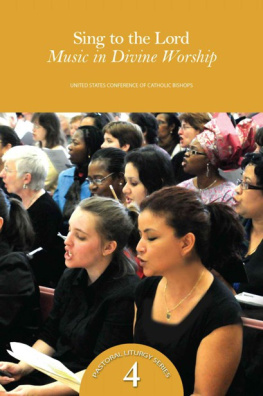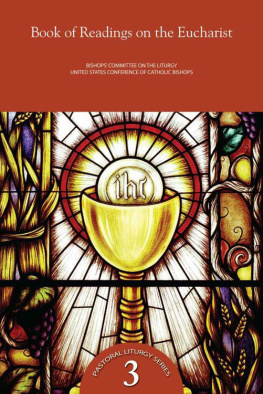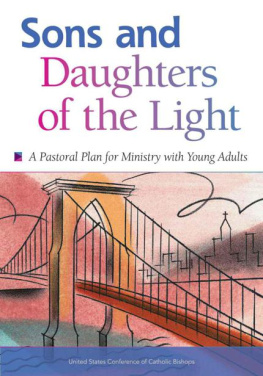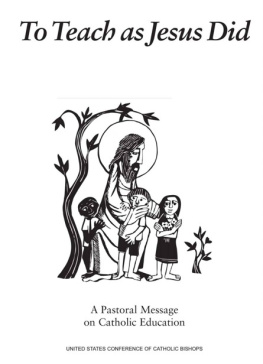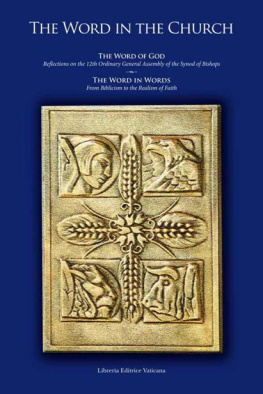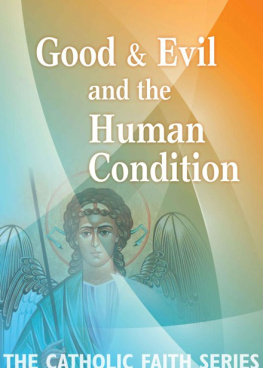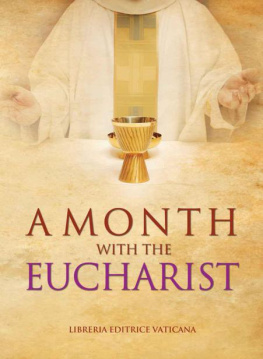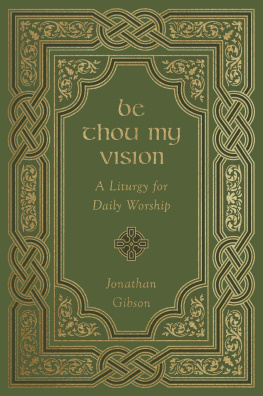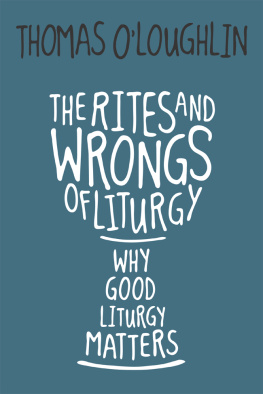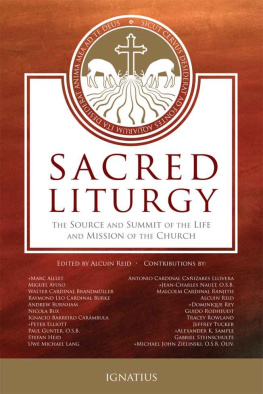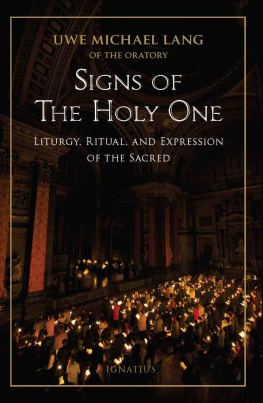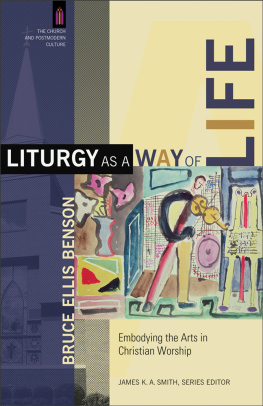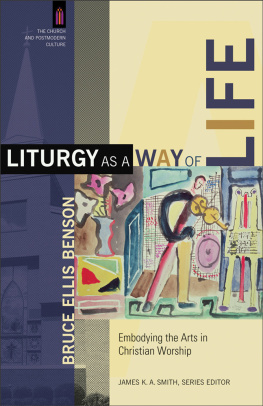Sing to the Lord
M usic in D ivine W orship
Updated to Reflect the Roman Missal, Third Edition
PASTORAL LITURGY SERIES FOUR
UNITED STATES CONFERENCE OF CATHOLIC BISHOPS
Washington, D.C.
Contents
Abbreviations
AG | Second Vatican Council, Ad Gentes Divinitus (Decree on the Churchs Missionary Activity) (1965) |
BCL | Bishops Committee on the Liturgy (now the Committee on Divine Worship) |
BLS | USCCB, Built of Living Stones: Art, Architecture, and Worship (2000) |
CCC | Catechism of the Catholic Church, 2nd edition |
CVL | USCCB, Co-Workers in the Vineyard of the Lord: A Resource for Guiding the Development of Lay Ecclesial Ministry (2005) |
DV | Second Vatican Council, Dei Verbum (Dogmatic Constitution on Divine Revelation) (1965) |
GILH | General Instruction of the Liturgy of the Hours |
GIRM | General Instruction of the Roman Missal |
GS | Second Vatican Council, Gaudium et Spes (Pastoral Constitution on the Church in the Modern World) (1965) |
HCWEOM | Holy Communion and Worship of the Eucharist Outside Mass |
LFM | Lectionary for Mass |
LTA | John Paul II, Letter to Artists (1999) |
MS | Sacred Congregation for Rites, Musicam Sacram (Instruction on Music in the Liturgy ) (1967) |
MSD | Pius XII, Musicae Sacrae Disciplina (On Sacred Music) (1955) |
OCF | Order of Christian Funerals |
ORD | Rites of Ordination of a Bishop, of Priests, and of Deacons, 2nd typical edition |
PCS | Pastoral Care of the Sick |
PL | Patrologiae cursus completes: Series Latina |
RBC | Rite of Baptism of Children |
RC | Rite of Confirmation |
RCIA | Rite of Christian Initiation of Adults |
RM | Rite of Marriage |
SacCar | Benedict XVI, Sacramentum Caritatis (Sacrament of Charity) (2007) |
SC | Second Vatican Council, Sacrosanctum Concilium (Constitution on the Sacred Liturgy) (1963) |
USCCB | United States Conference of Catholic Bishops |
Sing to the Lord: Music in Divine Worship , a revision of Music in Catholic Worship , was developed by the Music Subcommittee of the Committee on Divine Worship of the United States Conference of Catholic Bishops (USCCB). On November 14, 2007, the Latin Church members of the USCCB approved these guidelines. These guidelines are designed to provide direction to those preparing for the celebration of the Sacred Liturgy according to the current liturgical books (in the ordinary form of celebration).
Foreword
Greetings from the bishops of the United States to priests, deacons, liturgists, music directors, composers, cantors, choirs, congregations, and faith communities throughout the United States. Grace to you and peace from God our Father and the Lord Jesus Christ. It is our duty and our joy as shepherds of the Church to guide and oversee liturgical song in each particular Church. Liturgy is the source of the Churchs prayer and action, and the summit by which our lives and all our ministries ascend to the Father. We pray that this document will draw all who worship the Lord into the fullness of liturgical, musical prayer.
______________
Eph 1:1.
I. Why We Sing
1. God has bestowed upon his people the gift of song. God dwells within each human person, in the place where music takes its source. Indeed, God, the giver of song, is present whenever his people sing his praises.
2. A cry from deep within our being, music is a way for God to lead us to the realm of higher things. Music is therefore a sign of Gods love for us and of our love for him. In this sense, it is very personal. But unless music sounds, it is not music, and whenever it sounds, it is accessible to others. By its very nature song has both an individual and a communal dimension. Thus, it is no wonder that singing together in church expresses so well the sacramental presence of God to his people.
3. Our ancestors reveled in this gift, sometimes with Gods urging. Write out this song, then, for yourselves, God said to Moses. Teach it to the Israelites and have them recite it, so that this song may be a witness for me.
4. Jesus and his apostles sang a hymn before their journey to the Mount of Olives.
5. Obedient to Christ and to the Church, we gather in liturgical assembly, week after week. As our predecessors did, we find ourselves singing psalms, hymns and spiritual songs with gratitude in [our] hearts to God.
6. In human life, signs and symbols occupy an important place. As a being at once body and spirit, man expresses and perceives spiritual realities through physical signs and symbols.... Inasmuch as they are creatures, these perceptible realities can become means of expressing the action of God who sanctifies men, and the action of men who offer worship to God. This sacramental principle is the consistent belief of the Church throughout history. In Liturgy, we use words, gestures, signs, and symbols to proclaim Christs presence and to reply with our worship and praise.
7. The primordial song of the Liturgy is the canticle of victory over sin and death. It is the song of the saints, standing beside the sea of glass: They were holding Gods harps, and they sang the song of Moses, the servant of God, and the song of the Lamb.
8. The Paschal hymn, of course, does not cease when a liturgical celebration ends. Christ, whose praises we have sung, remains with us and leads us through church doors to the whole world, with its joys and hopes, griefs and anxieties.
9. Charity, justice, and evangelization are thus the normal consequences of liturgical celebration. Particularly inspired by sung participation, the body of the Word Incarnate goes forth to spread the Gospel with full force and compassion. In this way, the Church leads men and women to the faith, freedom and peace of Christ by the example of its life and teaching, by the sacraments and other means of grace. Its aim is to open up for all men a free and sure path to full participation in the mystery of Christ.
Participation
10. Holy Mother Church clearly affirms the role within worship of the entire liturgical assembly (bishop, priest, deacon, acolytes, ministers of the Word, music leaders, choir, extraordinary ministers of Holy Communion, and the congregation). Through grace, the liturgical assembly partakes in the life of the Blessed Trinity, which is itself a communion of love. In a perfect way, the Persons of the Trinity remain themselves even as they share all that they are. For our part, we, though many, are one body in Christ and individually parts of one another.
11. Within the gathered assembly, the role of the congregation is especially important. The full and active participation by all the people is the aim to be considered before all else, for it is the primary and indispensable source from which the faithful are to derive the true Christian spirit.
12. Participation in the Sacred Liturgy must be internal, in the sense that by it the faithful join their mind to what they pronounce or hear, and cooperate with heavenly grace.

